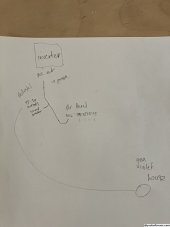jameshowison
New Member
- Joined
- Jul 30, 2021
- Messages
- 184
House has a generator inlet with interlock switch.
RV has a 3000W Victron inverter with sufficient batteries/wiring to provide sustained 25amp of 120v.
What do I need on the RV to enable connection to the generator inlet, to provide emergency power to the house?
Two issues:
1. AC panel in PV is full, I don’t want to rewire it. All outlets are GFCI protected.
2. RV inverter produces 120v AC. House generator interlock is 240v. I don’t need to power any 240v loads in the house. But I would like to power both sides of the panel with 120.
For the 120 to 240v my understanding is that I can provide same phase 120v to both hot pins on a SS2-50r 240v generator cable. 240v stuff will be off, but would see 0v differential between the hot pins. Currently I’m doing this with a SS2-50r (female) to TT-30p (male) “dog bone” adapter from Amazon Flameweld Generator Adapter Cord https://a.co/d/ckNy1Lp
I plugged that into a house outlet (using a regular outlet 120v 5-15p to TT-30r) and confirmed that 120v on both hot pins (to neutral and ground) but 0v between the hot pins.
However when plugging into the RV I only have GFCI 15amp outlets. With the generator inlet still off, if I connect the 15 amp outlet to the generator inlet, the GFCI instantly trips.
I don’t know whether that is caused by the 120 to both hots or the house having a ground to neutral bond. My understanding is that the Victron does not connect ground and neutral, unless the RV is being charged from the incoming shore power connection (which I don’t have connected to the house at present!)
At the RV end, I think I want the equivalent of an RV park pedestal. Ie a TT-30 outlet protected by its own circuit breaker (here I’d probably use a 25amp to reduce overloads on the inverter when the house was connected). I’m thinking of wiring that between the inverter and the RV panel, using a DIN railed mounted circuits breaker).
Basically that would give a non-GFCI outlet from the inverter for the generator cable to plug into.
Sorry for wall of text!

RV has a 3000W Victron inverter with sufficient batteries/wiring to provide sustained 25amp of 120v.
What do I need on the RV to enable connection to the generator inlet, to provide emergency power to the house?
Two issues:
1. AC panel in PV is full, I don’t want to rewire it. All outlets are GFCI protected.
2. RV inverter produces 120v AC. House generator interlock is 240v. I don’t need to power any 240v loads in the house. But I would like to power both sides of the panel with 120.
For the 120 to 240v my understanding is that I can provide same phase 120v to both hot pins on a SS2-50r 240v generator cable. 240v stuff will be off, but would see 0v differential between the hot pins. Currently I’m doing this with a SS2-50r (female) to TT-30p (male) “dog bone” adapter from Amazon Flameweld Generator Adapter Cord https://a.co/d/ckNy1Lp
I plugged that into a house outlet (using a regular outlet 120v 5-15p to TT-30r) and confirmed that 120v on both hot pins (to neutral and ground) but 0v between the hot pins.
However when plugging into the RV I only have GFCI 15amp outlets. With the generator inlet still off, if I connect the 15 amp outlet to the generator inlet, the GFCI instantly trips.
I don’t know whether that is caused by the 120 to both hots or the house having a ground to neutral bond. My understanding is that the Victron does not connect ground and neutral, unless the RV is being charged from the incoming shore power connection (which I don’t have connected to the house at present!)
At the RV end, I think I want the equivalent of an RV park pedestal. Ie a TT-30 outlet protected by its own circuit breaker (here I’d probably use a 25amp to reduce overloads on the inverter when the house was connected). I’m thinking of wiring that between the inverter and the RV panel, using a DIN railed mounted circuits breaker).
Basically that would give a non-GFCI outlet from the inverter for the generator cable to plug into.
Sorry for wall of text!



